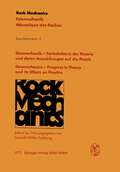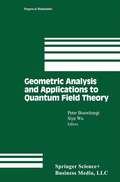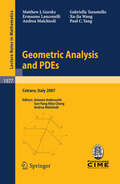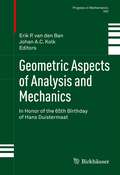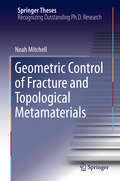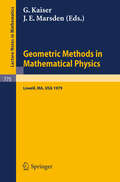- Table View
- List View
Geomechanics and Geodynamics of Rock Masses, Volume 1: Proceedings of the 2018 European Rock Mechanics Symposium
by Vladimir LitvinenkoThis book is Volume 1 of the EUROCK 2018 proceedings. Geomechanics and Geodynamics of Rock Masses contains contributions presented at EUROCK 2018, the 2018 International Symposium of the International Society for Rock Mechanics (ISRM 2018, Saint Petersburg, Russia, 22-26 May 2018). Dedicated to recent advances and achievements in the fields of geomechanics and geotechnology, the main topics of the book include:- Physical and mechanical properties of fractured rock (laboratory testing and rock properties, field measurements and site investigations)- Geophysics in rock mechanics- Rock mass strength and failure- Nonlinear problems in rock mechanics- Effect of joint water on the behavior of rock foundation- Numerical modeling and back analysis- Mineral resources development: methods and rock mechanics problems- Rock mechanics and underground construction in mining, hydropower industry and civil engineering- Rock mechanics in petroleum engineering- Geodynamics and monitoring of rock mass behavior- Risks and hazards- Geomechanics of technogenic depositsGeomechanics and Geodynamics of Rock Masses will be of interest to researchers and professionals involved in the various branches of rock mechanics and rock engineering. EUROCK 2018, organized by the Saint Petersburg Mining University, is a continuation of the successful series of ISRM symposia in Europe, which began in 1992 in Chester, UK.
Geomechanics and Geodynamics of Rock Masses, Volume 1: Proceedings of the 2018 European Rock Mechanics Symposium
by Vladimir LitvinenkoThis book is Volume 1 of the EUROCK 2018 proceedings. Geomechanics and Geodynamics of Rock Masses contains contributions presented at EUROCK 2018, the 2018 International Symposium of the International Society for Rock Mechanics (ISRM 2018, Saint Petersburg, Russia, 22-26 May 2018). Dedicated to recent advances and achievements in the fields of geomechanics and geotechnology, the main topics of the book include:- Physical and mechanical properties of fractured rock (laboratory testing and rock properties, field measurements and site investigations)- Geophysics in rock mechanics- Rock mass strength and failure- Nonlinear problems in rock mechanics- Effect of joint water on the behavior of rock foundation- Numerical modeling and back analysis- Mineral resources development: methods and rock mechanics problems- Rock mechanics and underground construction in mining, hydropower industry and civil engineering- Rock mechanics in petroleum engineering- Geodynamics and monitoring of rock mass behavior- Risks and hazards- Geomechanics of technogenic depositsGeomechanics and Geodynamics of Rock Masses will be of interest to researchers and professionals involved in the various branches of rock mechanics and rock engineering. EUROCK 2018, organized by the Saint Petersburg Mining University, is a continuation of the successful series of ISRM symposia in Europe, which began in 1992 in Chester, UK.
Geomechanics and Geodynamics of Rock Masses - Volume 2: Proceedings of the 2018 European Rock Mechanics Symposium
by Vladimir LitvinenkoThis book is Volume 2 of the EUROCK 2018 proceedings. Geomechanics and Geodynamics of Rock Masses contains contributions presented at EUROCK 2018, the 2018 International Symposium of the International Society for Rock Mechanics (ISRM 2018, Saint Petersburg, Russia, 22-26 May 2018). Dedicated to recent advances and achievements in the fields of geomechanics and geotechnology, the main topics of the book include: - Physical and mechanical properties of fractured rock (laboratory testing and rock properties, field measurements and site investigations)- Geophysics in rock mechanics- Rock mass strength and failure- Nonlinear problems in rock mechanics- Effect of joint water on the behavior of rock foundation- Numerical modeling and back analysis- Mineral resources development: methods and rock mechanics problems- Rock mechanics and underground construction in mining, hydropower industry and civil engineering- Rock mechanics in petroleum engineering- Geodynamics and monitoring of rock mass behavior- Risks and hazards- Geomechanics of technogenic deposits Geomechanics and Geodynamics of Rock Masses will be of interest to researchers and professionals involved in the various branches of rock mechanics and rock engineering. EUROCK 2018, organized by the Saint Petersburg Mining University, is a continuation of the successful series of ISRM symposia in Europe, which began in 1992 in Chester, UK.
Geomechanics and Geotechnics of Particulate Media: Proceedings of the International Symposium on Geomechanics and Geotechnics of Particulate Media, Ube, Japan, 12-14 September 2006
by Masayuki Hyodo Hidekazu Murata Yukio NakataMicroscopic re-examination of geomaterials consisting of aggregates can shed light on macroscopic behaviour, including compressibility, anisotropy, yielding, creep, cyclic liquefaction and shear rupture. As a result of this process of examination, new methods of material characterization emerge, leading to a greater degree of accuracy in the specification of new constitutive models with physically-meaningful parameters. The impetus behind this development is an increasing awareness on sustainability, leading to the more efficient use of recycled materials for geotechnical applications. The characteristics of recycled materials, such as compressibility and self-hardening, may differ significantly from those of natural materials, and it is crucial that evaluation is made from a specifically particulate perspective.
Geomechanics and Geotechnics of Particulate Media: Proceedings of the International Symposium on Geomechanics and Geotechnics of Particulate Media, Ube, Japan, 12-14 September 2006
by Masayuki Hyodo, Hidekazu Murata & Yukio NakataMicroscopic re-examination of geomaterials consisting of aggregates can shed light on macroscopic behaviour, including compressibility, anisotropy, yielding, creep, cyclic liquefaction and shear rupture. As a result of this process of examination, new methods of material characterization emerge, leading to a greater degree of accuracy in the specification of new constitutive models with physically-meaningful parameters. The impetus behind this development is an increasing awareness on sustainability, leading to the more efficient use of recycled materials for geotechnical applications. The characteristics of recycled materials, such as compressibility and self-hardening, may differ significantly from those of natural materials, and it is crucial that evaluation is made from a specifically particulate perspective.
Geomechanics, Fluid Dynamics and Well Testing, Applied to Naturally Fractured Carbonate Reservoirs: Extreme Naturally Fractured Reservoirs (Springer Theses)
by Nelson Enrique Barros GalvisThis thesis presents an important step towards a deeper understanding of naturally fractured carbonate reservoirs (NFCRs). It demonstrates the various kinds of discontinuities using geological evidence, mathematical kinematics model and computed tomography and uses this as a basis for proposing a new classification for NFCRs. Additionally, this study takes advantage of rock mechanics theory to illustrate how natural fractures can collapse due to fluid flow and pressure changes in the fractured media. The explanations and mathematical modeling developed in this dissertation can be used as diagnostic tools to predict fluid velocity, fluid flow, tectonic fracture collapse, pressure behavior during reservoir depleting, considering stress-sensitive and non-stress-sensitive, with nonlinear terms in the diffusivity equation applied to NFCRs. Furthermore, the book presents the description of real reservoirs with their field data as the principal goal in the mathematical description of the realistic phenomenology of NFCRs.
Geomechanics from Micro to Macro
by Kenichi Soga Krishna Kumar Giovanna Biscontin Matthew KuoGeomechanics from Micro to Macro contains 268 papers presented at the International Symposium on Geomechanics from Micro and Macro (IS-Cambridge, UK, 1-3 September 2014). The symposium created a forum for the dissemination of new advances in the micro-macro relations of geomaterial behaviour and its modelling. The papers on experimental investigati
Geomechanics in Soil, Rock, and Environmental Engineering
by John SmallUtilizes both Computer- and Hand-Based Calculations… Modern practice in geomechanics is becoming increasingly reliant on computer-based software, much of which can be obtained through the Internet. In Geomechanics in Soil, Rock, and Environmental Engineering the application of these numerical techniques is examined not only for soil mechanics, but also for rock mechanics and environmental applications. … For Use in Complex Analysis It deals with the modern analysis of shallow foundations, deep foundations, retaining structures, and excavation and tunneling. In recent years, the environment has become more and more important, and so it also deals with municipal and mining waste and solutions for the disposal and containment of the waste. Many fresh solutions to problems are presented to enable more accurate and advanced designs to be carried out. A Practical Reference for Industry Professionals, This Illuminating Book: Offers a broad range of coverage in soil mechanics, rock mechanics, and environmental engineering Incorporates the author‘s more than 40 years of academic and practical design experience Describes the latest applications that have emerged in the last ten years Supplies references readily available online for futher research Geomechanics in Soil, Rock, and Environmental Engineering should appeal to students in their final undergraduate course in geomechanics or master’s students, and should also serve as a useful reference to practitioners in the field of geomechanics, reflecting the author’s background in both industry and academia.
Geomechanics in Soil, Rock, and Environmental Engineering
by John SmallUtilizes both Computer- and Hand-Based Calculations… Modern practice in geomechanics is becoming increasingly reliant on computer-based software, much of which can be obtained through the Internet. In Geomechanics in Soil, Rock, and Environmental Engineering the application of these numerical techniques is examined not only for soil mechanics, but also for rock mechanics and environmental applications. … For Use in Complex Analysis It deals with the modern analysis of shallow foundations, deep foundations, retaining structures, and excavation and tunneling. In recent years, the environment has become more and more important, and so it also deals with municipal and mining waste and solutions for the disposal and containment of the waste. Many fresh solutions to problems are presented to enable more accurate and advanced designs to be carried out. A Practical Reference for Industry Professionals, This Illuminating Book: Offers a broad range of coverage in soil mechanics, rock mechanics, and environmental engineering Incorporates the author‘s more than 40 years of academic and practical design experience Describes the latest applications that have emerged in the last ten years Supplies references readily available online for futher research Geomechanics in Soil, Rock, and Environmental Engineering should appeal to students in their final undergraduate course in geomechanics or master’s students, and should also serve as a useful reference to practitioners in the field of geomechanics, reflecting the author’s background in both industry and academia.
Geomechanics of Failures
by Alexander M. Puzrin Eduardo E. Alonso Núria M. PinyolThe main goal of this introductory text is to demonstrate how basic concepts in Soil Mechanics can be used as a “forensic” tool in the investigation of geotechnical failures. This, in turn, provides a good opportunity to show how to use available procedures in the formulation of useful simple models. Geotechnical failure is understood here in a broad sense as the failure of a structure to function properly due to a geotechnical reason. Some of the geotechnical failures selected are well known for their impact on the geotechnical community. Others are closer to the author’s experience. They have been organized into three main topics: Settlement, Bearing Capacity and Excavations. They cover a significant proportion of every day’s activity of professional geotechnical engineers. No attempt has been made to create a comprehensive handbook of failures. Instead, the emphasis has been given to creative applications of simple mechanical concepts and well known principles and solutions of Soil Mechanics. The book shows how much can be learned from relatively simple approaches. Despite this emphasis on simplicity, the book provides a deep insight into the cases analyzed. A non-negligible number of new analytical closed-form solutions have also been found. Their derivation can be followed in detail. In all the cases described an effort was made to provide a detailed and step by step description of the hypothesis introduced and of the analysis performed.
Geomechanics of Failures. Advanced Topics
by Eduardo E. Alonso Núria M. Pinyol Alexander M. PuzrinGeotechnical failures, specially the catastrophic ones, are a stimulus to improve current understanding of phenomena and procedures and tools for analysis and prediction. This unconventional approach to geomechanics is the essence of this book. In general, soil mechanics and geotechnical textbooks describe first the concepts and theoretical developments and then apply them to interpret or solve a particular applications. This book follows a different course. The case (a failure) is first described and then an explanation is sought. This requires a set of steps which can be summarized as follows: Identify the nature of the problem, develop a dedicated and specific formulation of the case, based on established basic concepts. In general, no single existing theory or procedure is available to solve the case at hand, provide a solution within an acceptable degree of complexity, extract the fundamental aspects of the problem and highlight its relevance. The cases selected have been grouped into three main topics: Landslides, Embankments and Dams and Dynamics of Failures. Cases selected (Vaiont, Aznalcóllar, Brattas-St. Moritz) are unique and illustrate a number of relevant and to some extent controversial issues which are of wide interest, without claiming exhaustive treatment of the subject. The book teaches how to build the necessary models to understand the failures. Well established soil mechanics concepts are the necessary background. But the cases analyzed require in general a step ahead which is specific for the case analyzed. Balance and equilibrium equations are often required as a starting point. They are formulated at different scales, which are selected having in mind the abstract representation of each case. Various chapters illustrate also the coupled nature (flow-deformation-temperature) of geotechnical problems and the need to properly address these complexities in some cases. In fact, temperature effects, a subject often neglected in conventional analyses, are necessary to explain some catastrophic landslides (Vaiont). In some of the chapters, specific calculation tools, included in well known and widely available programs (Excel, Maple…) have been used. Details of the ad hoc programs developed have also been included in Appendices to help the readers to follow the details of the calculation. Finite element methods have not been used. In the landslides analyzed (Vaiont and Brattas-St. Moritz) currently available commercial programs are of limited utility. In the remaining cases the analysis performed provides a sufficient insight and interpretation of field behaviour. Chapters include also a short description of the changes in the original design and the mitigation measures which could have prevented the failure. Also, a summary section of lessons learned is provided in all chapters. Finally, selected topics and more advanced reading are suggested. This book is associated with a Master/Doctorate course being offered at the Department of Geotechnical Engineering and Geosciences of UPC, Barcelona. Potential readers therefore include Graduate and Master students, faculty and professionals in the fields of Civil and Geotechnical Engineering.
Geomechanics of Oil and Gas Wells (Advances in Oil and Gas Exploration & Production)
by Vladimir Karev Yuri Kovalenko Konstantin UstinovThe book presents an integrated approach to studying the geomechanical processes occurring in oil and gas-bearing formations during their development. It discusses the choice of a model that takes into account the basic properties of rocks; experiments to find model parameters; numerical modeling; and direct physical modeling of deformation and filtration processes in reservoir and host rocks. Taking into account features of rock behavior, such as anisotropy of the mechanical properties of rocks during elastoplastic deformation; dependence of permeability on the total stress tensor; the contribution of the filtration flow to the formation stress state; and the influence of tangential as well as normal stresses on the transition to inelastic deformation, it demonstrates how the presented approach allows the practical problems of increasing the productivity of wells, oil recovery, and ensuring the stability of wellbores to be solved.The book is intended for specialists, including geoengineers working in the oil and gas sector, teachers, graduate students and students, as well as all those interested in scientific and technological developments to meet the enormous demand for raw materials and energy.
Geomechanik — Fortschritte in der Theorie und deren Auswirkungen auf die Praxis / Geomechanics — Progress in Theory and Its Effects on Practice: Vorträge des 20. Geomechanik-Kolloquiums der Österreichischen Gesellschaft für Geomechanik / Contributions to the 20th Geomechanical Colloquium of the Austrian Society for Geomechanics (Rock Mechanics Felsmechanik Mecanique des roches. Supplementa #2)
by Leopold MüllerGeomechanik gebirgsbildender Vorgänge und deren Auswirkungen auf Felsbauten ober und unter Tage / Geomechanics of Orogenetic Events and Their Effects on the Construction of Rock Structures on Subsurface and Underground: Vorträge des Hans-Cloos-Kolloquiums (25. Geomechanik-Kolloquium) der Österreichischen Gesellschaft für Geomechanik / Contributions to the Hans-Cloos-Colloquium (25th Geomechanical Colloquium) of the Austrian Society for Geomechanics (Rock Mechanics Felsmechanik Mecanique des roches. Supplementa #6)
by Österreichische Gesellschaft für GeomechanikGeometric Analysis and Applications to Quantum Field Theory (Progress in Mathematics #205)
by Peter Bouwknegt Siye WuIn the last decade there has been an extraordinary confluence of ideas in mathematics and theoretical physics brought about by pioneering discoveries in geometry and analysis. The various chapters in this volume, treating the interface of geometric analysis and mathematical physics, represent current research interests. No suitable succinct account of the material is available elsewhere. Key topics include: * A self-contained derivation of the partition function of Chern- Simons gauge theory in the semiclassical approximation (D.H. Adams) * Algebraic and geometric aspects of the Knizhnik-Zamolodchikov equations in conformal field theory (P. Bouwknegt) * Application of the representation theory of loop groups to simple models in quantum field theory and to certain integrable systems (A.L. Carey and E. Langmann) * A study of variational methods in Hermitian geometry from the viewpoint of the critical points of action functionals together with physical backgrounds (A. Harris) * A review of monopoles in nonabelian gauge theories (M.K. Murray) * Exciting developments in quantum cohomology (Y. Ruan) * The physics origin of Seiberg-Witten equations in 4-manifold theory (S. Wu) Graduate students, mathematicians and mathematical physicists in the above-mentioned areas will benefit from the user-friendly introductory style of each chapter as well as the comprehensive bibliographies provided for each topic. Prerequisite knowledge is minimal since sufficient background material motivates each chapter.
Geometric Analysis and PDEs: Lectures given at the C.I.M.E. Summer School held in Cetraro, Italy, June 11-16, 2007 (Lecture Notes in Mathematics #1977)
by Matthew J. Gursky Ermanno Lanconelli Andrea Malchiodi Gabriella Tarantello Xu-Jia Wang Paul C. YangGeometric Aspects of Analysis and Mechanics: In Honor of the 65th Birthday of Hans Duistermaat (Progress in Mathematics #292)
by Erik P. Van Den Ban Johan A. C. KolkHans Duistermaat, an influential geometer-analyst, made substantial contributions to the theory of ordinary and partial differential equations, symplectic, differential, and algebraic geometry, minimal surfaces, semisimple Lie groups, mechanics, mathematical physics, and related fields. Written in his honor, the invited and refereed articles in this volume contain important new results as well as surveys in some of these areas, clearly demonstrating the impact of Duistermaat's research and, in addition, exhibiting interrelationships among many of the topics.
Geometric Control of Fracture and Topological Metamaterials (Springer Theses)
by Noah MitchellThis thesis reports a rare combination of experiment and theory on the role of geometry in materials science. It is built on two significant findings: that curvature can be used to guide crack paths in a predictive way, and that protected topological order can exist in amorphous materials. In each, the underlying geometry controls the elastic behavior of quasi-2D materials, enabling the control of crack propagation in elastic sheets and the control of unidirectional waves traveling at the boundary of metamaterials. The thesis examines the consequences of this geometric control in a range of materials spanning many orders of magnitude in length scale, from amorphous macroscopic networks and elastic continua to nanoscale lattices.
Geometric Invariant Theory, Holomorphic Vector Bundles and the Harder-Narasimhan Filtration (SpringerBriefs in Mathematics)
by Alfonso Zamora Saiz Ronald A. Zúñiga-RojasThis book introduces key topics on Geometric Invariant Theory, a technique to obtaining quotients in algebraic geometry with a good set of properties, through various examples. It starts from the classical Hilbert classification of binary forms, advancing to the construction of the moduli space of semistable holomorphic vector bundles, and to Hitchin’s theory on Higgs bundles. The relationship between the notion of stability between algebraic, differential and symplectic geometry settings is also covered.Unstable objects in moduli problems -- a result of the construction of moduli spaces -- get specific attention in this work. The notion of the Harder-Narasimhan filtration as a tool to handle them, and its relationship with GIT quotients, provide instigating new calculations in several problems. Applications include a survey of research results on correspondences between Harder-Narasimhan filtrations with the GIT picture and stratifications of the moduli space of Higgs bundles.Graduate students and researchers who want to approach Geometric Invariant Theory in moduli constructions can greatly benefit from this reading, whose key prerequisites are general courses on algebraic geometry and differential geometry.
Geometric Mechanics (Lecture Notes in Mathematics #1798)
by Waldyr Muniz OlivaGeometric Mechanics here means mechanics on a pseudo-riemannian manifold and the main goal is the study of some mechanical models and concepts, with emphasis on the intrinsic and geometric aspects arising in classical problems. The first seven chapters are written in the spirit of Newtonian Mechanics while the last two ones as well as two of the four appendices describe the foundations and some aspects of Special and General Relativity. All the material has a coordinate free presentation but, for the sake of motivation, many examples and exercises are included in order to exhibit the desirable flavor of physical applications.
Geometric Mechanics on Riemannian Manifolds: Applications to Partial Differential Equations (Applied and Numerical Harmonic Analysis)
by Ovidiu Calin Der-Chen Chang* A geometric approach to problems in physics, many of which cannot be solved by any other methods * Text is enriched with good examples and exercises at the end of every chapter * Fine for a course or seminar directed at grad and adv. undergrad students interested in elliptic and hyperbolic differential equations, differential geometry, calculus of variations, quantum mechanics, and physics
Geometric Methods in Mathematical Physics: Proceedings of an NSF-CBMS Conference Held at the University of Lowell, Massachusetts, March 19-23, 1979 (Lecture Notes in Mathematics #775)
by G. Kaiser J. E. MarsdenGeometric Methods in Physics: XXXIV Workshop, Białowieża, Poland, June 28 – July 4, 2015 (Trends in Mathematics)
by Piotr Kielanowski S. Twareque Ali Pierre Bieliavsky Anatol Odzijewicz Martin Schlichenmaier Theodore VoronovThis book features a selection of articles based on the XXXIV Białowieża Workshop on Geometric Methods in Physics, 2015. The articles presented are mathematically rigorous, include important physical implications and address the application of geometry in classical and quantum physics. Special attention deserves the session devoted to discussions of Gerard Emch's most important and lasting achievements in mathematical physics. The Białowieża workshops are among the most important meetings in the field and gather participants from mathematics and physics alike. Despite their long tradition, the Workshops remain at the cutting edge of ongoing research. For the past several years, the Białowieża Workshop has been followed by a School on Geometry and Physics, where advanced lectures for graduate students and young researchers are presented. The unique atmosphere of the Workshop and School is enhanced by the venue, framed by the natural beauty of the Białowieża forest in eastern Poland.
Geometric Methods in Physics XL: Workshop, Białowieża, Poland, 2023 (Trends in Mathematics)
by Piotr Kielanowski Daniel Beltita Alina Dobrogowska Tomasz GolińskiThis volume collects papers based on lectures given at the XL Workshop on Geometric Methods in Physics, held in Białowieża, Poland in July 2023. These chapters provide readers an overview of cutting-edge research in infinite-dimensional groups, integrable systems, quantum groups, Lie algebras and their generalizations and a wide variety of other areas. Specific topics include: Yang-Baxter equation The restricted Siegel disc and restricted Grassmannian Geometric and deformation quantization Degenerate integrability Lie algebroids and groupoids Skew braces Geometric Methods in Physics XL will be a valuable resource for mathematicians and physicists interested in recent developments at the intersection of these areas.
Geometric Methods in Physics XXXIX: Workshop, Białystok, Poland, 2022 (Trends in Mathematics)
by Piotr Kielanowski Alina Dobrogowska Gerald A. Goldin Tomasz GolińskiThis volume collects papers based on lectures given at the XXXIX Workshop on Geometric Methods in Physics, held in Białystok, Poland in June 2022. These chapters provide readers an overview of cutting-edge research in geometry, analysis, and a wide variety of other areas. Specific topics include:Classical and quantum field theoriesInfinite-dimensional groupsIntegrable systemsLie groupoids and Lie algebroidsRepresentation theoryGeometric Methods in Physics XXXIX will be a valuable resource for mathematicians and physicists interested in recent developments at the intersection of these areas.









